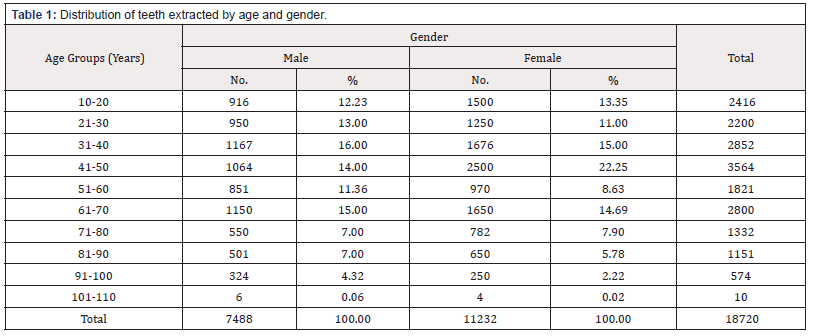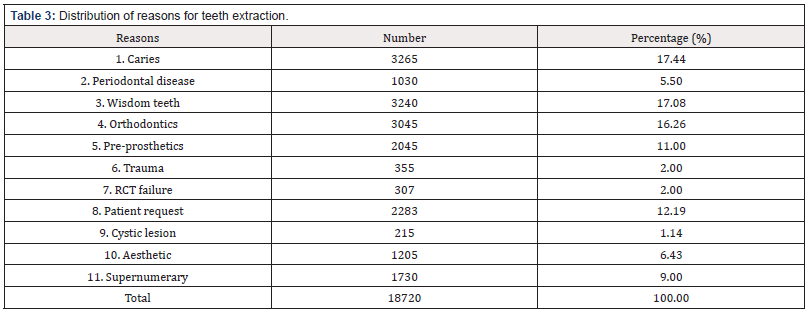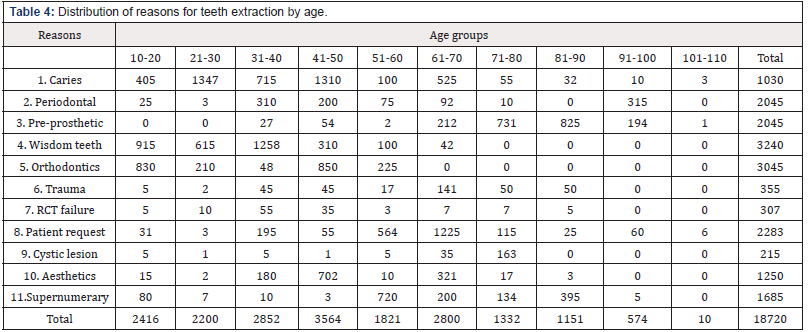Research Article 
 Creative Commons, CC-BY
Creative Commons, CC-BY
To Find Out the Causes of Extraction of Teeth in the Patients Coming to the Department of Oral and Maxillofacial Surgery at Kantipur Dental College Teaching Hospital and Research Center from January 2014 to December 2018
*Corresponding author: Bikash Desar, Chief of dental department, Oral and Maxillofacial Surgeon Patan academy of health sciences, Nepal.
Received: March 18, 2019 Published: April 04, 2019
DOI: 10.34297/AJBSR.2019.02.000580
Abstract
Objective: The main objective of this study is to find out the reasons for the extraction of the teeth on patients visiting to the Department of oral and maxillofacial surgery at Kantipur Dental College Teaching Hospital and Research Centre from 2014 January 1st to 2018 December 31st.
Materials and methods: The patients came to the department of oral and maxillofacial surgery department during the year 2014 January to 2018 December for the extractions were retrospectively analyzed for age, sex and the reasons for the extractions were found out.
Results: 18720 extractions were performed in 18720 patients. Here we selected the patients who went only single tooth extraction, so the extraction number of tooth and patient number are same. An age range of 10 to 110 years of patients were included. In patients. Dental caries (20%) seem to be the most common cause in case of males and wisdom tooth (19%) is the most commonly extracted tooth in case of females seen in our study. RCT failure(0.76%) is the least common cause for extraction in case of males and cystic lesion(0.84%) is the least common cause for extraction in case of females. Range of 18–110 years with a mean (±standard deviation) of 34.8 (13.3) was observed. Most of the patients were in the 21–30 years age group accounting for 35.7% of cases. The difference in proportions of reasons for tooth extraction between the gender was statistically significant (P = 0.02; df = 24). The difference in the reasons for extraction among the age groups was statistically significant (P < 0.001; df = 132).
Conclusion: Dental caries and wisdom teeth extraction is the most common cause for the extraction of teeth in the patients coming at the department of oral and maxillofacial surgery in Kantupur dental college teaching hospital and research center. Dental caries is the preventable disease, hence there is need of more awareness programmes for preventing the disease and even simple fillings only can save the teeth in large scale. Periodontal diseases also can be prevented or cured so that we can save the teeth of the patients. Most of the people have low income, so they want to go for extraction instead of saving them.
Introduction
Nepal being the developing country, we find most of the people going dental extraction even the teeth can be saved. Tooth extraction is the most common surgical procedure performed in the oral and maxillofacial surgery department. Extraction seems to be simple procedure, but it has significant impact in quality of life in individual’s life. Quality of general health and psychological consequences is totally hampered after extraction of tooth [1]. Globally, tooth loss has become a global public health concern [2,3]. Inspire of being preventable, dental caries has become the most common cause for extractions of teeth [4,5]. Similar in our study too dental caries is the common cause for extraction of teeth and wisdom teeth being the second cause where as in other studies periodontal cause being the second cause for the extraction of tooth.
Oral hygiene status of the patients, education level, socioeconomic status and individual quality of life always determines the extraction of tooth [2,4,6]. Not only has this, in today’s world eating patter of population had much bad impact in oral hygiene which also have great role in extractions [7,8]. Different kinds of oral diseases and etiological factors exhibit interand intra –regional variations 9. Very few studies are found about extraction in our country and this seems to be the first entity to the best of our knowledge(Table 1).
Materials and Methods
With the permission from Hospital and through consent of patients we collected the records of patients, who had undergone extractions of teeth at the department of oral and maxillofacial surgery in Kantipur Dental College Teaching Hospital and Research Center between January 2014 and December 31st 2018 were retrieved. It is purely Dental college with 100 bedded medical unit. It is located in central part of city where patients come from all over the country.
Patients aged 10years to 110 years were included who went extraction of only one tooth at that time. Patient’s age, gender, year of presentation, presenting complaint, type of tooth and reason for extraction were documented. Reasons for extraction of tooth were classified into the following categories;
a. Caries
b. Wisdom tooth (pericorinitis)
c. Orthodontic purpose
d. Patient’s request
e. Preprosthetic purpose
f. Supernumerary
g. Aesthetic
h. Periodontal disease
i. Cystic lesions
j. Trauma
k. RCT failure(Table 2-4)
Discussion
Tooth extraction is one of the most frequently performed procedures in the department of oral and maxillofacial surgery department 10. Tooth loss may affect the quality of life and it is an important marker of oral hygiene and it may predict other conditions such as cardiovascular events and poor cognitive function [11]. Moreover, it may be an indication of patients’ disposition and access to oral care [2,3].
There was a slight female predominance, which is in agreement with other studies [12,3]. But in discordance with the report by Byahatti and Ingafou [13]. The slight female predominance may be due to the better health-seeking behavior of females compared to their male counterparts [14,15]. A comparison of the mean age of the patients displayed no statistically significant difference for sex. Majority of the patients were in the third decade of life in case of males and 4th decade of life in case of females, which contrasts with the report of Chrysanthakopoulos and Vlassi, who reported the fourth decade of life as the model decade of presentation in a study conducted in Greece 16. However, it is in agreement with the report of Saheeb and Sede [12]. This may suggest geographical variations in the pattern of presentation among patients having dental extractions.
Comparable to some previous studies, mandibular teeth were more often extracted than maxillary teeth although other studies observed that maxillary teeth were more often extracted [2,17- 19]. The propensity of food and plaque accumulation to occur more around the mandibular teeth, thus increasing susceptibility to caries formation, may be responsible for this observation [1]. In our study we didn’t compared between maxillary and mandibular teeth extraction.
DCS were the reasons for extraction in a little over half of the extractions done. This is in sharp contrast with earlier reports by other Nigerian authors, where caries and its sequelae were the reasons for extraction in an overwhelming majority of extractions done. On the other hand, it is similar to the account of Lesolang et al. 20 and Byahatti and Ingafou 13 who reported caries and its sequelae as the reasons for extraction in 47.9% and 55.9% of extractions done, respectively. Indeed, caries and its sequelae were the most common reasons for extraction observed in all age groups <60 years of age. The most frequently extracted teeth due to caries and its sequelae were the molars, with the lower left first molar being the most commonly extracted tooth. Treatment preference for carious tooth is often extraction rather than conservation, especially where among patients of low socioeconomic status [21,22].
Orthodontic reasonwas the second most frequent reason for dental extractions in this study. Although previous studies in Southwestern Nigeria revealed periodontitis as the most frequent reason for extraction caries was the most commonly encountered reason for extraction in this study 23. Orthodonticwas the reason for extraction in 17% of extractions done; this is much lower than the proportions observed by Lesolang et al. but higher than figures reported by Alesia and Khalil [3,20]. The reason for increasing orthodontic extraction may be due to increased number of patients wiling for orthodontic treatment. A retrospective study among a suburban Southwestern Nigerian population reported periodontal disease as a reason for extraction in a higher proportion of the patients (24.6%) 24. This may be a reflection of the changing pattern of dental extraction in Nepal. The increasing consumption of refined food among the population and improved oral hygiene might have led to a reduction in the proportion of extractions due to periodontal disease and a corresponding increase in the proportion of extractions secondary to caries and its sequelae. Periodontal disease was the major reason for extraction among patients in the 7th decade of life and above.
Recurrent pericoronitis was the third most common reason for extractions, accounting for almost as many extractions as periodontal disease. Tooth impaction represented15% in males and 19% in females for the reasons of extractions among Patients visiting in our departmentpatients which is quite significant [23]. Significantly, the proportion of teeth extracted on account of pericoronitis secondary to third molar impaction is much higher than the values reported from other parts of country [2,12,23]. However, it is still lower than values reported from the western world where prophylactic extraction of impacted third molars is relatively common [25,26]
Trauma was the least common reason for dental extractions; the Majority of extractions done due to trauma was mostly among patients in the 3rd to 4th decade of life. Notably, trauma was not recorded as a cause of extraction in patients older than 70 years. This may be due to the relatively sedentary lifestyle and generally less involvement in assault or interpersonal violence of people with increasing age 27. Most teeth extracted due to trauma were the anterior teeth; this may be because of their location in a relatively less protected region.
Cystic lesion was less causative factor for extractions in this study, which is comparable to other studies [2,23]. However, this is quite low compared to studies from the western world [28]. Other reasons for extraction observed in this study include failed root canal therapy, prosthetic reasons, and supernumerary teeth, patients request due to economic status, and aesthetic cause. Although these accounted for a comparatively small proportion of the cases seen, the percentages observed are comparable to previous studies [29-35].
Conclusion
DCS were the major reasons for tooth mortality in this study, especially among patients in the third and fourth decades of life. This highlights the importance of dental caries in public health. To stem this trend, we recommend urgent inclusion of oral healthcare in the existing primary healthcare system of our region, improved accessibility of oral healthcare facilities by deploying mobile dental facilities, intensification of oral healthcare awareness campaigns, increased recruitment of dental experts, and fluoridation of community water supply. Furthermore, a research designed to explore the reasons for late presentation among dental patients should be instituted. Nepal being the poorest country in the world, people here prefer to go for extraction even that can be safed. Due to low income even teeth that can be restored, patients they don’t want to save.
References
- Furuichi Y, Lindhe J, Ramberg P, Volpe AR (1992) Patterns of de novo plaque formation in the human dentition. J Clin Periodontol 19: 423-433.
- Taiwo OA, Sulaiman AO, Obileye MF, Akinshipo A, Uwumwonse AO, et al. (2014) Patterns and reasons for childhood tooth extraction in Northwest Nigeria. J Pediatr Dent 2(3): 83-87.
- Alesia K, Khalil HS (2013) Reasons for and patterns relating to the extraction of permanent teeth in a subset of the Saudi population. Clin Cosmet Investig Dent 5: 51-56.
- Dixit LP, Gurung CK, Gurung N, Joshi N (2010) Reasons underlying the extraction of permanent teeth in patients attending Peoples Dental College and Hospital. Nepal Med Coll J 12: 203-206.
- Kashif M, Mehmood K, Ayub T, Aslam M (2014) Reasons and patterns of tooth extraction in a tertiary care hospital-A cross sectional prospective survey. LiaquatUni Med Health Sci 13(3):125-129.
- La Torre G, Romeo U, Iarocci G, Brugnoletti O, Semyonov L, et al. (2015) Socio-demographic inequalities and teeth extraction in the last 12 months in Italy. Ann Stomatol (Roma) 5:131–135.
- Luan WM, Baelum V, Chen X, Fejerskov O [1989] Tooth mortality and prosthetic treatment patterns in urban and rural Chinese aged 20-80 years. Community Dent Oral Epidemiol 17:221-226.
- Varenne B, Petersen PE, Ouattara S (2006) Oral health behaviour of children and adults in urban and rural areas of Burkina Faso, Africa. Int Dent J 56: 61–70.
- Odai CD, Azodo CC, Ezeja EB, Obuekwe ON (2010) Reasons for exodontia in rural Nigerian children. Odontostomatol Trop 33:19-24.
- Anyanechi C, Chukwuneke F (2012) Survey of the reasons for dental extraction in Eastern Nigeria. Ann Med Health Sci Res 2:129-133.
- Park H, Suk SH, Cheong JS, Lee HS, Chang H, et al. (2013) Tooth loss may predict poor cognitive function in community-dwelling adults without dementia or stroke: The PRESENT project. J Korean Med Sci 28:1518- 1521.
- Saheeb BD, Sede MA(2013) Reasons and pattern of tooth mortality in a Nigerian Urban teaching hospital. Ann Afr Med 12: 110-114.
- Byahatti SM, Ingafou MS (2011) Reasons for extraction in a group of Libyan patients. Int Dent J 61:199–203.
- Oliver MI, Pearson N, Coe N, Gunnell D (2005) Help-seeking behaviour in men and women with common mental health problems: Cross-sectional study. Br J Psychiatry 186: 297-301.
- Thompson AE, Anisimowicz Y, Miedema B, Hogg W, Wodchis WP, et al. (2016) The influence of gender and other patient characteristics on health care-seeking behaviour: A QUALICOPC study. BMC Fam Pract 17:38.
- Chrysanthakopoulos NA, Vlassi CK (2013) Reasons and risks of permanent teeth extraction. The general dental practice in Greece. Int J Med Dent 3:4.
- Hamasha AA, Sasa I, Al-Qudah M (2000) Risk indicators associated with tooth loss in Jordanian adults. Community Dent Oral Epidemiol 28: 67- 72.
- Shakenvosky BN, Lownie JF, Leaton-Jones PE (1986) Reasons for tooth loss in Blacks on the Witwatersrand. J Dent Assoc S Afr 41: 41-44.
- Du Plessis JB (1987) The reasons for and pa erns of tooth loss in parents treated at Ga-Rankuwa Hospital. J DASA 42: 593-599.
- Lesolang RR, Motloba DP, Lalloo R(2009) Patterns and reasons for tooth extraction at the Winterveldt Clinic: 1998-2002. SADJ 64: 214-215. 218.
- Donaldson AN, Everitt B, Newton T, Steele J, Sherriff M, et al. (2008) The effects of social class and dental attendance on oral health. J Dent Res 87: 60-64.
- Gilbert GH, Duncan RP, Shelton BJ (2003) Social determinants of tooth loss. Health Serv Res 38(6 Pt 2):1843-1862.
- Odusanya SA (1987) Tooth loss among Nigerians: Causes and pattern of mortality. Int J Oral Maxillofac Surg 16:184-189.
- Oginni FO (2005) Tooth loss in a sub-urban Nigerian population: Causes and pattern of mortality revisited. Int Dent J 55: 17-23.
- Friedman JW (2007) The prophylactic extraction of third molars: A public health hazard. Am J Public Health 97: 1554-1559.
- Adeyemo WL (2006) Do pathologies associated with impacted lower third molars justify prophylactic removal? A critical review of the literature. Oral Surg Oral Med Oral Pathol Oral Radiol Endod 102: 448- 452.
- De Rezende LF, Rey-López JP, Matsudo VK, Do Carmo Luiz O (2014) Sedentary behavior and health outcomes among older adults: A systematic review. BMC Public Health 14: 333.
- Mc Caul LK, Jenkins WM, Kay EJ (2001) The reasons for the extraction of various tooth types in Scotland: A 15-year follow up. J Dent 29: 401-417.
- Jafarian M, Etebarian A (2013) Reasons for extraction of permanent teeth in general dental practices in Tehran, Iran. Med Princ Pract 22: 239-244.
- Mberu BU, Reed HE (2014) Understanding subgroup fertility differentials in Nigeria. Popul Rev 53: 23-46.
- Adebowale SA, Fagbamigbe FA, Okareh TO, Lawal GO (2012) Survival analysis of timing of first marriage among women of reproductive age in Nigeria: Regional differences. Afr J Reprod Health 16: 95-107.
- Adebowale AS, Yusuf BO, Fagbamigbe AF (2012) Survival probability and predictors for woman experience childhood death in Nigeria: “Analysis of North-South differentials” BMC Public Health 12: 430.
- Sumaila AF (2013) Road crashes trends and safety management in Nigeria. J Geography Regional Plann 6: 53.
- Adeleke OO, Salami AW, Oyewo ST (2013) Trend of highway accidents in Nigeria using highway accident hazard index. Ann Fac Eng Hunedoar 11: 231.
- Danjibo ND (2009) Islamic Fundamentalism and Sectarian Violence: The ‘Maitatsine’ and ‘Boko Haram’ crises in Northern Nigeria. Peace and Conflict Studies Paper Series 1-21.







 We use cookies to ensure you get the best experience on our website.
We use cookies to ensure you get the best experience on our website.